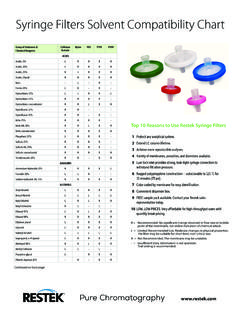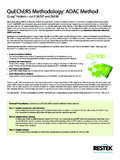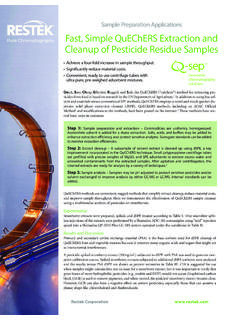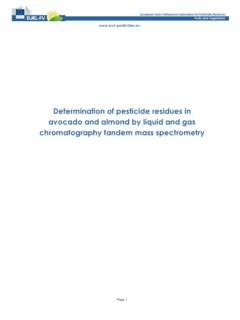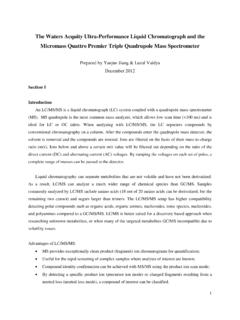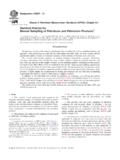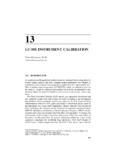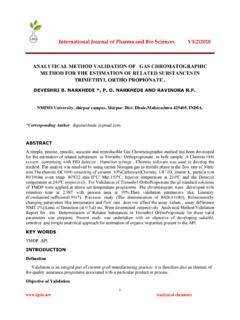Transcription of A Technical Guide for Static Headspace Analysis, …
1 Inside:Basic Principles of HeadspaceAnalysisInstrumentationSystem Optimization(Troubleshooting) Headspace ApplicationsRecommended Headspace AnalysisProductsTechnical GuideA Technical Guidefor Static HeadspaceAnalysis Using e of Cont entsInt roduction .. 2 Basic Principles of HeadspaceAnalysis .. 3 Partition Coefficient Phase Ratio Combining K and Derivatization/ReactionHeadspace Headspace Sample SizeInstrumentation .. 6 Gas-Tight Syringe Injection Balanced-Pressure System Pressure-Loop SystemSystem Optimization(Troubleshooting) .. 8 Sample Preparation Sample Via l Sample Vial Heater and Mixer Sampling Transfer Line Injection Port Interfac eHeadspace Applications .. 11 Blood Alcohol Analysis USP <467> European Pharmacopoeia TestsRecommended Headspace AnalysisProducts.
2 15 Capillary Columns Guard Columns Press-Tight Connectors Analytical Reference Materials GC Accessoriestatic Headspace gas chromatography (GC) is a technique used for the concentra-tion and analysis of vol atile organic compounds. This technique is relativelySTime and money are two of the many reasons why an analystwould use Static Headspace analy sis. Oth er reasons may in cl udeease of ope ra tion and the abili ty to assay a variety of and can pr ovide sensitivity similar to dynamic pu rge and tr ap analysis. T hepopularity of this te chnique has grown and has gained worldwide acceptance fo ranalyses of alcohols in blood and residual solvents in pharmaceutical common applications include industrial analyses of monomers in polymersand plastic, fl avor compounds in beverages and food products, and fr agrances inperfumes and matrices li ke blood, plastic, and cosmetics contain high molecular weight,non-vol atile material th at can remain in the GC system and result in poor analyticalperfo rmance.
3 Many laboratory analysts use extensive sample preparation te chniquesto extract and concentrate the compounds of interest from this un wanted non-vol atile material. These ext raction and concentration te chniques can become timeconsuming and costly . St atic Headspace analysis avoids this time and cost by di rectlysampling the volatile Headspace from the container in which the sample is of the diversities in the industry and related products, this Guide attempts tocover only the basic principles of st atic Headspace and demonstrate how to applythem to achi eve optimum ch romat ogr aphic results. With an understanding of theseprinciples, various instrumentation will then be revi ewed to help build upon thiskn owledge and identify the benefits and potential pr oblems associated with eachmode of sample transfe r.
4 In formation from the Basic Principles and Instrumentationsections of this Guide can then be brought together and applied to the conditions an dmethodology of common analyses. Li ke most applications, a variety of pro blemsmay arise in which the System Optimization section will help to identify thesepr oblems and offer techniques to help resolve 1 Phases of the Headspace 1 Partition Coefficient (K) = Cs/CgEquation 2 Phase Ratio ( ) = Vg/VsCs=concentration of analyte in sample phaseCg=concentration of analyte in gas phaseVs=volume of sample phaseVg=volume of gas phaseFigure 2K and are important variables inheadspace ,1, ethyl IK Values of Common Solvents in Air-Water Systems at 40 CBasic Principles of Headspace AnalysisMost consumer products and biological samples are composed of a wide variety ofcompounds that differ in molecular weight, polarity, and volatility.
5 For complexsamples like these, Headspace sampling is the fastest and cleanest method foranalyzing volatile organic compounds. A Headspace sample is normally prepared ina vial containing the sample, the dilution solvent, a matrix modifier, and theheadspace (see Figure 1). Volatile components from complex sample mixtures canbe extracted from non-volatile sample components and isolated in the Headspace orvapor portion of a sample vial. An aliquot of the vapor in the Headspace is deliveredto a GC system for separation of all of the volatile order to achieve the best performance when using Headspace /GC, careful atten-tion should be used in sample preparation and instrument setup. Key issues toaddress when setting up Headspace /GC systems include minimizing system deadvolume, maintaining inert sample flow paths, and achieving efficient sampletransfer.
6 These issues, as well as other instrument setup-related topics, are addressedlater in the System Optimization section of this must be prepared to maximize the concentration of the volatile componentsin the Headspace , and minimize unwanted contamination from other compounds inthe sample matrix. To help determine the concentration of an analyte in theheadspace, you will need to calculate the partition coefficient (K), which is definedas the equilibrium distribution of an analyte between the sample phase and the gasphase (Figure 2).Partition CoefficientCompounds that have low K values will tend to partition more readily into the gasphase, and have relatively high responses and low limits of detection (Figure 3). Anexample of this would be hexane in water: at 40 C, hexane has a K value of inan air-water system.
7 Compounds that have high K values will tend to partition lessreadily into the gas phase and have relatively low response and high limits ofdetection. An example of this would be ethanol in water: at 40 C, ethanol has a Kvalue of 1355 in an air-water system. Partition coefficient values for other commoncompounds are shown in Table , dilutionsolvent, and matrixmodifier}}GSG=the gas phase ( Headspace ).The gas phase is commonly referred to as the headspaceand lies above the condensed sample sample sample phase contains the compound(s) of interestand is usually in the form of a liquid or solid in combina-tion with a dilution solvent or a matrix the sample phase is introduced into the vial and thevial is sealed, volatile components diffuse into the gasphase until the Headspace has reached a state of equilib-rium as depicted by the arrows.
8 The sample is then takenfrom the (Ideal)KCg(Ideal)Figure 3 Sensi tiv it y is in crease d when Kis minimize and Figure 5 Lower K and result in higher Cgand better chlorideammonium sulfat esodium chloridesodium citratesodium sulfat epotassium carbonateTable IICommon salts used to decreasematrix effects.(Ideal) CgFigure 4 Sensitivity is increased when is can be lowered by changing th etemperature at which the vial is equili-brated or by changing the composition ofthe sample matrix. In the case of ethanol,K can be lowered from 1355 to 328 byraising the temperature of the vial from40 C to 80 C. It can be lowered evenfu rther by introducing inorganic salt intothe aqueous sample matrix. High saltconcentrations in aqueous samplesdecrease the solubility of polar organicvol atiles in the sample mat rix and promote their transfer into the Headspace ,resulting in lower K values.
9 However, the magnitude of the salting-out effect on K isnot the same for all compounds. Compounds with K values that are already rela-tively low will experience very little change in pa rtition coefficient after adding asalt to an aqueous sample matrix. Generally, volatile polar compounds in polarmat rices (aqueous samples) will experience the la rgest shifts in K and have higherresponses after the addition of salt to the sample matrix. Table II lists most of th ecommon salts used for salting-out RatioThe phase ratio ( ) is de fined as the relative volume of the Headspace compared tovolume of the sample in the sample vial (Figure 2). Lower values for ( , la rge rsample size) will yield higher responses for vol atile compounds (Figure 4). How-ever, dec reasing the value will not al ways yield the increase in response needed toimprove sensitivity.
10 When is decreased by increasing the sample size, compoundswith high K values partition less into the Headspace compared to compounds withlow K values, and yield co rrespondingly smaller changes in Cg. Samples th at containcompounds with high K values need to be optimized to pro vide the lowest K val uebefore changes are made in the phase K and Partition coefficients and phase ratioswork together to determine the finalconcentration of vol atile compounds inthe Headspace of sample vials. Theconcentration of vol atile compounds inthe gas phase can be expressed asCg=Co/(K+ ) (where Cg is the concen-tration of volatile analytes in the gasphase and Co is the original concentra-ti on of volat ile analytes in the sample).St riving for the lowest values for bothK an d will result in higher concentra-tions of volatile analytes in the gasphase an d, there fo re , better sensitivity(Figure 5).

